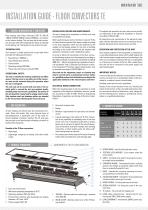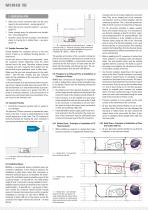
Catalog excerpts

INSTALLATION GUIDE - FLOOR CONVECTORS IE Floor heating units (floor convector) COIL-TE (750 W, 1 500 W, 2 250 W, 3 000 W) made by MINIB,a.s. are intended for interior heating. The unit uses the forced convection principle where the tangential fan blows air laterally to the heating coil. The heated air then enters the room. TECHNICAL DATA: Each product is visibly marked with a type label which provides the following information: Manufacturer: MINIB,a.s. Type identification: COIL-TE Serial number Operating voltage 230V 50Hz Power input (of the basic module) 750W OPERATIONAL SAFETY: The unit is intended for heating residential and office spaces. The top cover or any other part of the convector must not be removed during the operation when the unit is energized. The unit must not be covered with any items. If the air outlet grille is covered the unit may overheat locally. Handling water near the unit is prohibited. The surface of the unit should be cleaned only by wiping with dry cloth. Only stainless steel and aluminum grilles are intended for the TE convector. Wooden grille may not be used. INSTALLATION, REPAIRS AND MAINTENANCE: The unit is designed for installation in the floor and must be installed horizontally. Before performing any work on the floor convector TE the unit must be disconnected from power supply according to the local regulation which must be prepared by the supplier of the heating system for the room or building according to the control method and the required safe operation, maintenance and, if applicable, repairs. In terms of electrical connection of the floor convector the heating project must be prepared according to the CSN standards, including but not limited to CSN 33 2000-5-51 - Electrical engineering regulations, Electrical equipment, Part 5: Selection and erection of electrical equipment. Protection against electrocution must be ensured according to CSN 33 2000-4-41. Any work on the equipment, repair or cleaning may only be carried out by a professional service station or a qualified professional ultimately according to the applicable standards at the relevant place and time! ELECTRICAL MAINS CONNECTION: Before the heating system is put into operation an initial inspection of the electrical installation must be carried out according to CSN 33 1500 “Electrical Engineering Regulations, Inspections and testing of Electrical Installations”. Throughout the operation the user must ensure periodical inspections of the electrical installation in intervals according to CSN 33 1500. All inspections and connections of the electrical installation shall be ultimately carried out according to the applicable standards at the relevant place and time. OPERATION AND PROTECTION OF THE UNIT: Each heating segment of the equipment is protected by a reversible temperature limiter which safely isolates the coils from the power supply upon local overheating in the event of an incidental covering of the hot air outlet grilles or in the event of a failure of the fan. After cooled down, the coils will be re-connected to the power supply and start working again. IMPORTANT NOTICE: In terms of electrical protection we recommend connecting the convectors via a standardized power outlet protected by a residual-current circuit breaker. Handling water near the unit is prohibited. Checks of the correct function of the unit, including the check of the function of the reversible temperature limiters, must be carried out at least once a year, always before the heating season. Contact a professional service station or a qualified professional. A floor heating unit which uses the convection principle. Since the heater fully uses physical laws of thermodynamics it represents one of the most efficient methods of interior heating. The TE unit uses the principle or air flow through a heating coil which is powered by electricity. Benefits of the TE floor convectors: High output Lightweight compared to heating units with similar output Very short response time Design Minimum requirements for operation and maintenance A great advantage of the electrical TE floor convectors is the possibility of embedding them in the floor of the room. This is beneficial particularly in places where we do not want to disturb the overall appearance of the interior with wall-mounted, free-standing convectors, or other heating units, but where sufficient heating output is required. No construction works required in terms of heating water inlet and outlet lines and drainage pipe. fig. i: COMPONENTS OF THE TE FLOOR CONVECTOR H4- ™ICAL PARAMOS Use: dry environment Maximum operating temperature: 95 °C Operating medium 230 V AC 50 Hz Environment: interiors with temperatures ranging between +5°C and +40°C Power supply: 230 V AC 1. TROUGH - Stainless steel all-metal trough - stainless steel AISI 304. 2. MAIN COVER - Stainless steel cover of the TE heating modules. 3. SCREW M4X6 - Used for fixing the main cover. 4. TOOTHED LOCK WASHER - Lock washer under the screw heads. 5. STRUT - All-metal strut used for bracing the convector trough during installation. 6. STANDARD FRAME - The standard frame is a design element and should be perfectly aligned with final floor or minimally flushed (0-1 mm). 7. BASE - Intended for convector mounting and accurate positioning in unfinished floor. 8. ADJUSTING SCREW - Intended for fine positioning of convector before pouring of concrete. 9. WOOD SCREW - For fixing the base to the floor. 10. SCREW ANCHOR - For fixing the screw in the concrete floor. 11. TE module - Fan unit with the heating coil. 12. KADO cable connection box - Terminal box for connecting the 230V / 50Hz power supply. 13. CABLE GROMMET - Intended for 230VAC power supply cable.
Open the catalog to page 1
channels which are located outside the convector body. They are an integral part of the convector, and therefore must be ordered together with the convector production. The u-channels provide stability of the TE convector in hollow floors. (Figure 4). 5. BEFORE INSTALLATION Select the correct convector type from the catalogue for dry environment – see paragraph 5.1 Select the correct convector position – see paragraph 5.2 Leave enough space for placement and installation – see paragraph 5.3 Consider using thermal insulation, anti-vibration sheet, or bracing for in hollow floors – see...
Open the catalog to page 2All MINIB catalogs and technical brochures
-
NCA
2 Pages
-
NCA 4P
2 Pages
-
SKB
2 Pages
-
SPB
2 Pages
-
INNOVATIVE ACTIVE CHILLED BEAM
12 Pages
-
NKB
2 Pages
-
NPB
2 Pages
-
NEWS
28 Pages
-
THE BESTSELLING CONvECTORS
52 Pages
-
IG - DP CONVECTORS
2 Pages
-
IG - SK CONVECTORS
2 Pages
-
IG - KZ CONVECTORS
2 Pages
-
FLOOR CONVECTORS with fan
47 Pages
-
CONTROL ACCESSORIES
24 Pages
-
CONTTROLS
3 Pages
-
WALL-MOUNTED AND FREE-STANDING
40 Pages
-
FLOOR CONVECTORS
72 Pages
-
WALL FREE CONVECTORS
36 Pages
-
DESIGN CONVECTORS
12 Pages
-
NEWS MINIB
3 Pages
-
BEST OF MINIB
11 Pages
-
CATALOGUE MINIB
108 Pages
-
COIL – PT300
1 Pages
Archived catalogs
-
COIL – SK PTG - NK PTG
1 Pages
-
COIL - SW250
1 Pages
-
COIL- SP2/4
1 Pages
-
COIL – SP1/4
1 Pages
-
COIL – NP2/4
1 Pages
-
COIL – NP1/4
1 Pages
-
COIL – SU2
1 Pages
-
COIL – SU1
1 Pages
-
COIL – NU2
1 Pages
-
COIL – NU1
1 Pages
-
COIL – DP
1 Pages
-
COIL – LP
1 Pages
-
COIL – SK2
2 Pages
-
COIL – SK1
2 Pages
-
COIL – NK1
2 Pages
-
COIL – KP
1 Pages
-
COIL – TE
1 Pages
-
COIL-KT3 105
2 Pages
-
COIL – KT110
2 Pages
-
COIL – MT2
2 Pages
-
COIL – KT3
2 Pages
-
COIL – HCM4pipe
2 Pages
-
COIL – HCM
2 Pages
-
COIL – HC4pipe
2 Pages
-
COIL – HC
2 Pages
-
COIL – M0
2 Pages
-
COIL – MT
2 Pages
-
COIL – KT2
2 Pages
-
COIL – KT1
2 Pages
-
COIL – T 60
2 Pages
-
COIL – KTO
2 Pages
-
COIL – T80
2 Pages
-
COIL-T50
2 Pages
-
COIL – KT
2 Pages
-
COIL – KO
2 Pages
-
COIL – PW
1 Pages
-
COIL – PT180
1 Pages
-
COIL – PT80
1 Pages
-
COIL – PO
1 Pages
-
COIL – PT
1 Pages
-
COIL – P
1 Pages
-
COIL – SW420
1 Pages
-
COIL – NW340
1 Pages
-
COIL – NW170
1 Pages
-
COIL – PMW205
1 Pages
-
COIL – PMW165
1 Pages
-
COIL – PT105
1 Pages
-
COIL – PMW90
1 Pages
-
COIL – PMW125
1 Pages
-
Minib TH-0343 Termostat
1 Pages
-
Minib TH-0108 Termostat
88 Pages
-
MINIB 2009
88 Pages



















































































